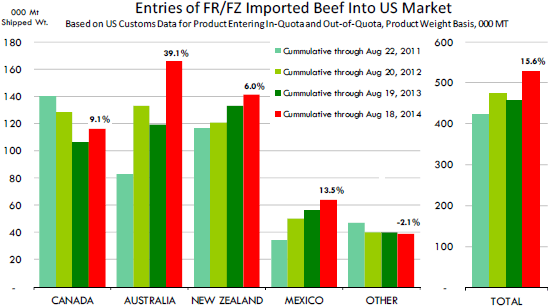For a while, US beef imports, especially imports from Australia, were in a downtrend as prices in the US stagnated while other markets were willing to pay more. That situation changed dramatically this year. According to data from US Customs Service, entries of imported beef in the US through 18 August were up 15.6 per cent compared to the same period a year ago.

The increase was largely driven by a surge in imports from Australia. Customs data pegs total imports of Australian beef at 165,840 MT, 46,648 MT (+39 per cent) more than the comparable period a year ago. And the numbers are likely to increase further in the next 30-45 days considering that Australian beef exports are the highest they have been in the past decade.
Australian beef exports to the US in July (much of this meat has yet to clear customs) were pegged at 36,799 MT, 108 per cent above year ago levels and the largest monthly volume since June 2008. We expect Australian beef shipments in August to be around 36,000 MT again, double what they were in August 2013.
If we account for the estimated shipments in August (which should be close), total Australian exports to the US for the period Jan - Aug are currently expected to be 226,559 MT, some 90,267 MT or 66 per cent higher than the previous year.
What does this additional 90,267 MT of beef from Australia represent? It converts to an additional 200 million pounds of beef (product weight basis) that have become available to US end users, much of that increase coming during the Mar - Aug period as prices for lean grinding beef hit record highs.
Another way to look at the impart of higher Australian imports is to see what has happened with US cow slaughter so far this year. Keep in mind that over 75 per cent of Australian beef entering the US is manufacturing beef, in other words beef that will be used by grinders and processors in making hamburger patties for foodservice, frozen dinners sold at retail or, at the high end, grass fed ground beef sold at a premium both at retail and foodservice.
We estimate total US cow slaughter for the period Jan - Aug (based on actual USDA weekly data and our forecast for the next few weeks) at 3.628 million head, down 592,232 head (-14 per cent) from the same period a year ago. The average dressed carcass weight for cows (per USDA data) so far this year has been around 630 pounds.
A decline of 592k head or so implies a reduction in cow meat of about 373,106 million pounds between Jan-Aug. And this is on a carcass weight basis. The rule of thumb is to figure a yield of 300 to 350 pounds from the 630 pound carcass is lean and extra lean grinding beef. In other words, we have had a decline of about 178 to 208 million pounds of lean grinding beef due to the decline in cow slaughter, a shortage that has been largely offset by the increase in Australian beef imports.
In addition to the increase in imports from Australia, we also have seen more beef imported from New Zealand and Mexico but for the most part, the surge in imported beef has been largely accounted for by higher Australian beef imports.





